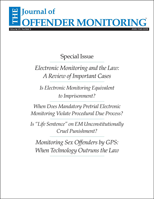Creativity and Effectiveness in the Use of Electronic Monitoring: A Case Study of Five European Jurisdictions
Author: Anthea Hucklesby.; Kristel Beyens.; Miranda Book.; Frieder Dunkel.; Gill McIvor Hannah Grahm.
Source: Volume 27, Number 02, Fall/Winter 2014 , pp.5-14(10)

< previous article |next article > |return to table of contents
Abstract:
Electronic Monitoring has been used in a number of EU member states since the turn of the 21st century. There has been much mutual learning, faciliated by governments and probation services themselves, the CEP (the European Probation Organisation) and the tech companies who supply the monitoring equipment (and who in Britain run EM services under central government contract). New countries continue to take up EM, as their penal problems become more pressing and as the use of digital technologies become ever more normal in government, commerce and everyday life. While offical rhetoric surrounding the use of EM in Europe is ostensibly similar, it has nonethless been embedded in very different legal and policy frameworks in different countries. Anthea Hucklesby, Professor of Criminology at the University of Leeds, was already a major British researcher on electronic monitoring before she and four senior European colleagues applied sucessfully for an “Action Grant” to the European Commission’s Directorate of General Justice to undertake the first major comparative study of EM in the European Union. Four member states, each with mature and established EM schemes, took part: Germany, the Netherlands, Belgium and Britain, the latter comprising the two separate jurisdictions of England and Wales, and Scotland, who began using EM in very similar ways but increasingly envisage its future it very differently. Each of the lead researchers recruited staff to undertake the work over an eighteen month period. An Advisory Board comprising experts drawn from academia, the judiciary, the civil service and the private sector was appointed to comment of progress and assist with opening doors in the countries being researched. The project was subdivided into four complementary work streams, sequenced in a logical order, with each building on the knowledge acquired in its predecessor. The first documented the legal and policy contexts in which EM operated in the five jurisdictions. The second mapped the ways in which EM is implemented, explored the varying conceptions of effectiveness that prevailed in relation to it and traced the influence of policy transfer between countries. It gathered as much statistical data on patterns of use and outcomes as was possible in each country. The third utilized the comparative knowledge and findings to draw out similarities and differences between the jurisdictions and drew preliminary conclusions about better and worse forms of implementation. The fourth work stream focused on developing a dissemination strategy through the use of documentary material (reports, briefing papers and articles), conferences and workshops. Six briefing papers were produced at the end of the project, one on each of the jurisdictions and one which compared and summarized the findings. The latter is reproduced with permission in this issue of the journal. Separate dissemination conferences took place in each of the jurisdictions, except Scotland (in London, Berlin, Brussels and Utrecht) conveying the results to policy and practitioner audiences. Comparative overviews were further presented at an academic conference in Paris and at the 10th CEP Electronic Monitoring conference in Riga, Latvia, in April 2016.Keywords: European Union Criminal Justice sentencing; EM modalities; objectives of electronic monitoring;compliance, enforcement, and breach
Affiliations:
1: Criminal Justice Programme of the European Union; 2: CJP-EU; 3: CJP-EU; 4: CJP-EU; 5: CJP-EU.